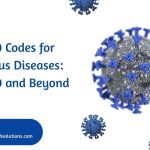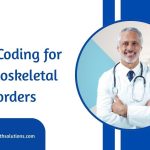
ICD-10 Codes for Infectious Diseases: COVID-19 and More
August 25, 2025
ICD-10 Coding for Musculoskeletal Disorders
September 8, 2025Respiratory diseases represent one of the most complex coding categories in ICD-10-CM, with over 200 specific codes covering conditions from simple asthma to severe COPD exacerbations. For medical billing professionals, accurate respiratory coding is crucial for proper reimbursement and compliance. At Skyshine Health Solutions, we’ve processed thousands of respiratory disease claims, and we understand the nuances that can make or break your coding accuracy. This comprehensive guide will walk you through the essential ICD-10 codes for respiratory diseases, common coding challenges, and best practices to ensure clean claims submission.
Understanding ICD-10 Respiratory Disease Categories
Chapter 10: Diseases of the Respiratory System (J00-J99)
The respiratory system chapter in ICD-10-CM is organized into several key blocks:
J00-J06: Acute upper respiratory infections
J09-J18: Influenza and pneumonia
J20-J22: Other acute lower respiratory infections
J30-J39: Other diseases of upper respiratory tract
J40-J47: Chronic lower respiratory diseases
J60-J70: Lung diseases due to external agents
J80-J84: Other respiratory diseases principally affecting the interstitium
J85-J86: Suppurative and necrotic conditions of the lower respiratory tract
J90-J94: Other diseases of the pleura
J95: Intraoperative and postprocedural complications
J96-J99: Other diseases of the respiratory system
Key ICD-10 Codes for Common Respiratory Diseases
Asthma (J45.-)
-
-
-
- J45.0 – Allergic asthma
- J45.1 – Nonallergic asthma
- J45.2 – Mixed asthma
- J45.3 – Mild intermittent asthma
- J45.4 – Mild persistent asthma
- J45.5 – Severe persistent asthma
- J45.9 – Asthma, unspecified
-
-
Chronic Obstructive Pulmonary Disease (COPD) (J44.-)
-
-
-
- J44.0 – COPD with acute lower respiratory infection
- J44.1 – COPD with acute exacerbation
- J44.9 – COPD, unspecified
-
-
Pneumonia (J12-J18)
-
-
-
- J12.- – Viral pneumonia
- J13 – Pneumonia due to Streptococcus pneumoniae
- J14 – Pneumonia due to Haemophilus influenzae
- J15.- – Bacterial pneumonia, not elsewhere classified
- J18.9 – Pneumonia, unspecified organism
-
-
Bronchitis (J20-J22, J40-J42)
-
-
-
- J20.9 – Acute bronchitis, unspecified
- J21.- – Acute bronchiolitis
- J41.0 – Simple chronic bronchitis
- J42 – Unspecified chronic bronchitis
-
-
Respiratory Failure (J96.-)
-
-
-
- J96.00 – Acute respiratory failure, unspecified whether with hypoxia or hypercapnia
- J96.01 – Acute respiratory failure with hypoxia
- J96.02 – Acute respiratory failure with hypercapnia
- J96.10 – Chronic respiratory failure, unspecified
- J96.20 – Acute and chronic respiratory failure, unspecified
-
-
Ventilator-Associated Conditions
-
-
-
- J95.851 – Ventilator associated pneumonia
- Z99.11 – Dependence on respirator [ventilator] status
-
-
Common Coding Pitfalls and How to Avoid Them
1. Overlooking Combination Codes
Many respiratory conditions have combination codes that include complications so use J44.0 for COPD with acute lower respiratory infection (don’t code separately) and use J45.902 for unspecified asthma with status asthmaticus
2. Missing Laterality Requirements
Some respiratory codes require laterality specification like Pneumothorax codes (J93.-) often require laterality so always check if laterality is required for accurate coding
3. Incorrect Use of “Unspecified” Codes
Only use unspecified codes when documentation truly lacks specificity so query physicians for missing details before defaulting to unspecified codes and review documentation thoroughly for implied specificity
4. Forgetting External Cause Codes
Respiratory conditions due to external causes require additional coding like pneumoconiosis requires external cause codes (Chapter 20) and drug-induced respiratory conditions need external cause identification
Documentation Requirements for Accurate Coding
Asthma:
-
-
- Type (allergic, nonallergic, mixed)
- Severity (intermittent, mild persistent, moderate persistent, severe persistent)
- Status (with/without exacerbation, status asthmaticus)
-
COPD:
-
-
- Presence of acute exacerbation
- Associated infections
- Functional status when relevant
-
Pneumonia:
-
-
- Causative organism when known
- Anatomical location
- Associated complications
-
Best Practices
-
-
-
Document Specificity: Note severity, triggers, and complications (e.g., respiratory failure, J96).
-
Use Combination Codes: Link COPD with infections (J44.0) or emphysema (J43.9).
-
Include Risk Factors: Code smoking (Z72.0) or environmental exposures (Z57.31).
-
Stay Updated: Check CMS for annual code updates.
-
Collaborate with Coders: Ensure documentation supports codes to avoid denials.
-
-
Final Words
Accurate ICD-10 coding for respiratory diseases requires attention to detail, thorough documentation review, and ongoing education. By following these guidelines and staying current with coding updates, medical billing professionals can ensure optimal reimbursement while maintaining compliance. At Skyshine Health Solutions, we specialize in complex medical billing scenarios, including respiratory disease coding. Our certified coding professionals stay current with all ICD-10-CM updates to maximize your practice’s revenue cycle performance.

Learn more on ICD-10 Codes for Infectious Diseases: COVID-19 and More
Check Reviews how we have improved lives















